Page last updated 31/05/07
A Tour In Westmorland by Sir Clement Jones, published 1948
CHAPTER III
THE UPPER EDEN
SEDBERGH - CAUTLEY SPOUT -
WHARTON - LAMMERSIDE
PENDRAGON CASTLE - THE RIVER EDEN
- MALLERSTANG
EDGE - KIRKBY STEPHEN - HARTLEY
We left Burneside by car on
Monday morning, 2nd June, in a blaze of sunshinewith the barometer at set-fair.
Our plan for the day was first to drive to the Cross Keys Inn on the road from
Sedbergh to Kirkby Stephen; to walk from there to Cautley Spout waterfall; to
have lunch at the Cross Keys; and in the afternoon to see three ruined castles
(Lammerside, Pendragon and Hartley); two old churches (Mallerstang and Kirkby
Stephen); one historic farmhouse (Wharton Hall); and the upper part of the
Eden Valley between Wild Boar Fell and Mallerstang Edge. Before we went to bed
that night we had seen them all.
First then to Cautley Spout in
the Howgill Fells, or, as you would say if you had been used to looking at them
from Burneside, "at the back of the Howgills." The best plan is to leave your
car, or your bicycle or your pack or whatever you don't want on a walk, at the
Cross Keys and start walking from there. The inn is a solid, stone building
with its date, 1732, above the door, and on its signboard is a painting of a
bottle of ginger-beer, indicating the temperance nature of the hotel. There is
a large, comfortable sitting-room in front and a sort of covered loggia at the
back of the house giving shade and shelter, very pleasant for a meal after a
walk on a really hot day like to-day, or on a wet one.
Unlike many other walks to
waterfalls in Westmorland where, in the turn of a path or a gap in the trees,
you may suddenly come upon the roar and the rocks, or as in the case of Stock
Ghyll Force at Ambleside you may pass close by without seeing the fall at all,
here at Cautley Spout you have your objective in full view the whole way. Such
is the formation of the ground that you see the Spout from the Sedbergh road,
from the Cross Keys, from the fields all around; there it is, straight ahead of
you, tumbling down the mountain side, and there is, therefore, no need to
explain the way up to it. It is in fact a tributary of the Lune, for its water
flows at the foot of the fell into the Rawthey river (which near here is, for a
short distance, the boundary between Westmorland and Yorkshire) which joins the
Lune below Sedbergh. 1 It is odd that two fine
waterfalls, each of them close to the Westmorland border and yet separated by
many miles should have such similar names - Cautley Spout which we were now
seeing, and Caldron Snout in Teesdale which we were to visit a few days later.
But they are entirely different in their volume and in the nature of their fall,
for whereas Caldron Snout is a cataract carrying the full force of the river
Tees above Maize Beck, Cautley Spout is but a relatively small stream which is
precipitated in three leaps from a height of about 800 feet into a dark pool
below.
As Wordsworth wrote of Dungeon
Ghyll:-
"The gulf is deep below,
And in a basin black and small
Receives a lofty waterfall."
The beauty of Cautley Spout lies
in its setting in the mountain side and it forms a fine picture, especially
after recent rain. Most people when they see a waterfall want to get close to
it and look up at it from below and down into it from above, and, if possible,
as at Niagara, to put on mackintoshes and stand between in and the rock. And so
it was with us; drawn on by this magnet, in spite of the great heat, we crossed
the beck below and began our climb. The first thing we noticed - and it was one
with which we were to become only too familiar on our walks during the next few
days - was the smell of dead sheep on the fells. Numbers of carcasses, in
various stages of putrefaction, victims of the blizzard, lay all around on the
ground. In one place about 20 yards square I counted five of these.
As we climbed we noticed a pair
of buzzards wheeling over our heads, circling with that apparently motionless
spread of wing that looks for all the world as if these birds were trying to
imitate aeroplanes. Some weeks later I read an article on Vermin,2
in which the question was raised whether buzzards should be
classed as vermin or whether the fact that they help to keep down rabbits puts
them into another and better class.
"Buzzards," wrote the author of
this article, "are common in large areas of wild country and their usefulness as
rabbit gourmands is immense. A buzzard, like a raven, will probably not bother
to kill anything, if there is a good feed of carrion to be had." I have no
doubt that "Mouton à la Blizzard" was on the menu that day at Cautley.
We reached the edge of the
waterfall and sat down under some mountain-ash trees in order to listen to it
and cool-off a little, quite content on this occasion not to make a closer
inspection of the leaps and black basins wither from above or from below. We
then turned to go back to the Cross Keys.
We saw nothing rare in the way
of birds that morning - mostly pippits and larks - and the flowers that we
noticed on this walk were also what you would expect to find, and be glad to
see, but "nothing to write home about": potentilla, water avens, louse-wort (pendicularis
palustris), ladies' mantle (alchemilla vulgaris), milk-wort and yellow pansies -
quite an ordinary lot, as you might say; but the beauty of flowers seen on a
walk is independent of the rarity of specimens. What would I not give to see a
few of the commonest fox-gloves and campions and stars of Bethlehem by the side
of the road on my daily journey from the Thames Embankment to Whitehall?
We were joined at lunch at the
Cross Keys, according to plan, by my cousin James Cropper, who, in addition to
his many other activities as Lord Lieutenant and as chairman of many committees
and other undertakings in Westmorland, is a noted and knowledgeable bird-watcher
and is also greatly interested in ancient buildings. Kept in Kendal by meetings
all morning he came with us on our afternoon expedition in the Upper Eden
Valley. Lunch over, we crossed the border from Yorkshire into Westmorland at
Rawthey Bridge and proceeded north to Wharton Hall, near Kirkby Stephen, which
was our first stopping place.
WHARTON
The Whartons of Wharton
Hall were "a considerable family" as early as the reign of Edward I. The first
of their stock mentioned in the College of Herablds is Thomas de Wahrton who
held the manor in the time of Henry VI, but they did not become ennobled until
the reign of Henry VIII when Sir Thomas Wharton, knight, was advanced to the
dignity of a baron for his signal victory over the Scots at Sollom Moss in
1542. Subsequently, with Lord Dacre, he marched into Scotland and captured
Dumfries. He was summoned to Parliament as a baron in 1545 and died in 1568.
3
His great-grandson Philip, 4th
Lord Wharton, was a distinguished Roundhead and Puritan and was colonel of a
regiment or horse under Cromwell. He bequeathed 1,050 Bibles to be distributed
yearly among that number of children in Westmorland, Cumberland and certain
other counties. His son Thomas, 5th Lord Wharton, was one of the most active
agents in the revolution which placed William of Orange on the English throne,
and though afterwards resolutely opposed to the Tory Ministry in the reign of
Anne, nevertheless he was created an earl in 1706 and a marquess
in 1715. 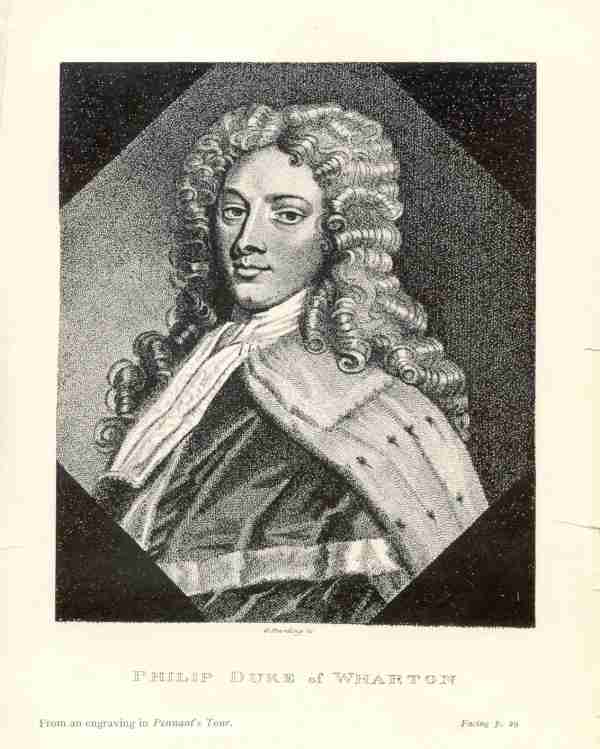
He was known amongst
his own party as "Honest Tom Wharton." His son Philip, the 6th baron and 2nd marquess, was but seventeen years of age at the time of his father's death in
1716. He was a person of unbounded genius, eloquence and ambition, but he was
extravagant in cultivating the arts of popularity and ruined his career by his
eccentricity and profligate conduct. Starting as a violent Whig, for his
extraordinary services in Parliament and out, he was created, in 1718, Duke of
Wharton. After that he set up in opposition to the Whig Ministry, became a
Tory, then a Jacobite, then a rebel against his King and country by accepting a
commission in the King of Spain's army against Gibraltar. Finally he retired
into a Bernardine monastery in Catalonia, where he died childless in 1731, aged
32, when all his titles became extinct, except the barony. 4
Thus the ancient family of Wharton which had flourished in Westmorland for some
500 years came to an end in this district. The estates had previously been sold
in 1728 to one of the Lowthers.
When Pennant made his tour
through Westmorland in 1773, he found people living who "well remembered this
British Clodio and bear witness to the profligacy of his character; to his
hunting upon Sundays, and shewing in all his actions an equal contempt of the
laws of God and Man." Alexander Pope has immortalised him in the following
lines:-
"Wharton, the scorn and wonder
of our days,
Whose ruling passion was the lust of praise:
Born with whate'er could win it from the wise,
Women and fools must like him or he dies:
Tho' wond'ring Senates hung on all he spoke,
The Club must hail him master of the hoke.
Thus with each gift of nature and or art,
And wanting nothing but an honest heart,
Grown all to all, from no one vice exempt
And most contemptible to shun contempt.
Ask you why Wharton broke through every rule?
T'was all for fear the knaves should call him fool."
Wharton Hall, about two miles
south of Kirkby Stephen, has long been in ruins and is now occupied as a
farmhouse. It stands well on an eminence near the river Eden. The buildings
surround an irregular, quadrangular courtyard, about 160 feet long by 90 feet
wide. The original block of the north-east corner was built late in the 14th or
early in the 15th century; then, in the reign of Henry VIII, a new great
dining-hall and kitchen were added to the south-east of the earlier part of the
house about 1540 by Thomas, 1st Lord Wharton, who later, in 1559, built the
massive gatehouse through which you enter to-day. It is an interesting example
of the larger mediaeval and later houses of the county. Previous to living here
the Whartons are said to have resided at Lammerside Castle, the ruins of which
are still to be seen about half a mile away to the south.
The great hall, the kitchen and
the gatehouse at Wharton Hall are now in ruins but enough remains to show what a
fine place it has been. In the olden time hospitality must have been on a lavish
scale; two vast fireplaces that you can still see in the old Tudor kitchen and
another one, 12 feet wide, in what remains of the great dining-hall, bear
witness to former feasts. In my youth I was told that in the great days of
Wharton Hall there was stabling for 40 horses, and indeed it is difficult,
considering the size of the place, the state of the roads, and the coming and
going from London, to see how they could have done with less.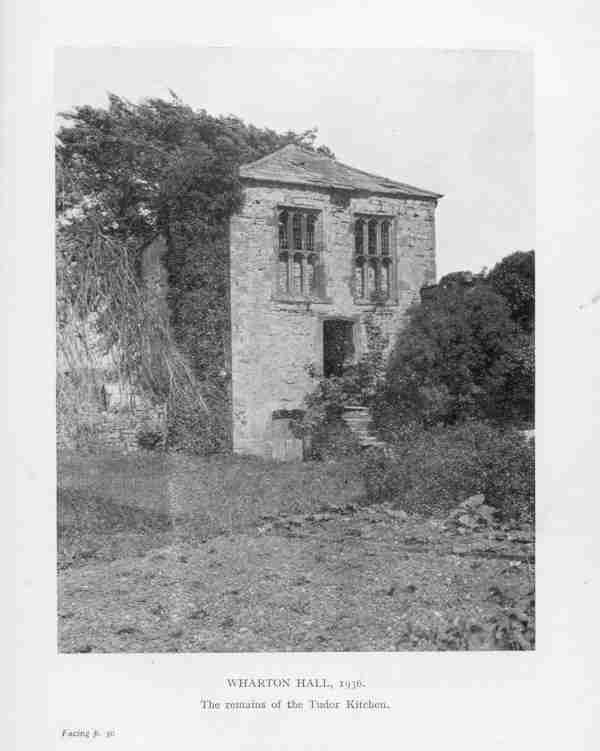
One of the tragedies of the
break-up of estates, due to heavy taxation, is that so many of our lovely,
ancient halls and farmhouses must inevitably fall into disrepair unless
something is done to save them. The Ministry of Works cannot be expected to take
them all under its official wing, nor, except in rare cases, can the new owners
find the money, even if they have the inclination to carry out the work of
restoration; the National Trust has not the funds. And yet one must hope that a
way may be found to interest more people in the preservation of beautiful things
and thereby increase the number of
subscribers to the National Trust. For what is the alternative? Surely it is
that there will be few if any of these old buildings left for those who come
after us to see. I take Wharton merely as an example, but what I have said
applies equally to Middleton Hall and Beetham Hall to which I shall come later.
I give two illustrations of Wharton: the earlier one from Pennant's "Tour" when
the rot had already started to set in; the later one from the Report of the
Historical Monuments Commission of 1936, when the rot was far more advanced.
When we visited the place in 1947 the state of the fabric, after only 11 years
since the photograph was taken, was noticeably worse. For instance, in the great
Tudor kitchen several elder trees - those powerful and unwanted intruders - were
thrusting their roots and branches into a really lovely piece of architecture.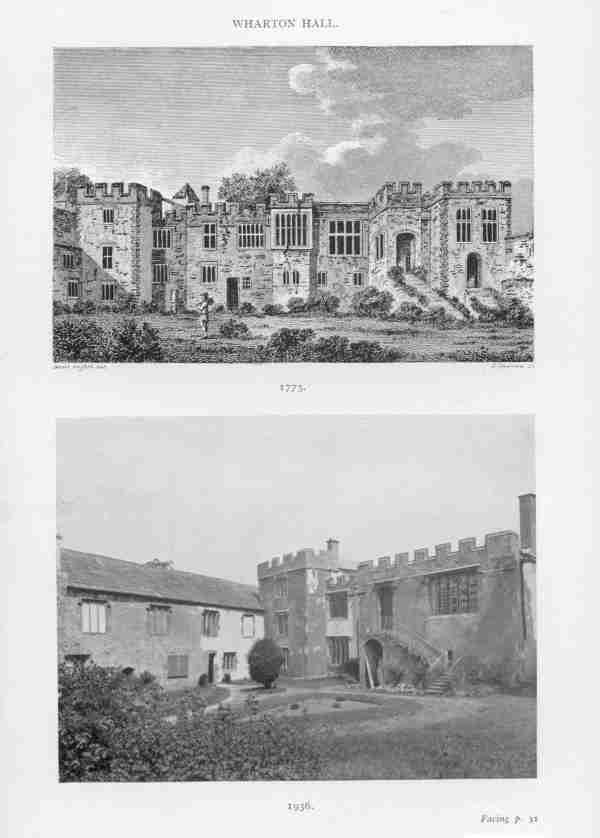
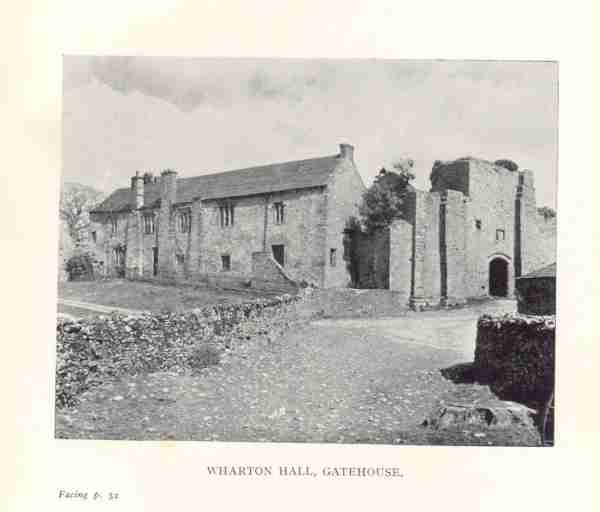
The fact is that while Englishmen
take a great interest in old paintings and old furniture and in the restoring of
them, they seem to care very much less for their old buildings. If the owner of
a famous picture is reluctantly obliged to part with it, at once a hue and cry
is raised all over England protesting that the painting must be saved for the
nation, subscriptions are raised, donors come forward, while all the time our
old and beautiful buildings are crumbling into decay.
I should like here to quote two
authorities on this subject of architecture and the survivals of old houses.
Osbert Sitwell has written:5 "Alas! how curious
it is that these works of art only begin to obtain a wide appreciation when they
are on the verge of being destroyed... What country houses of any size, one
wonders, can hope to survive the next fifty years?" The same point has been made
by Harold Nicolson in his review of a book on architecture in the Daily
Telegraph: "English people," he wrote, "are not interested in architecture... If
I could feel that I had been able to arouse an interest in architecture in only
ten of my fellow citizens, I should cross the Styx with the conviction that my
life had not been wholly wasted... If you enjoy looking at buildings you can
indulge your pleasure from the top of a 'bus." No such vehicle, however, passes
Wharton Hall, and in any case the crumbling process has been going on there
before buses were invented. In 1777 Dr. Burn reported that "the hall is now in
ruins and desolate, inhabited by no human creature but a poor hind."
Then came a day about 20 years
ago when the fate of this hall and its possible restoration hung in the balance.
A member of one of the branches of the Wharton family came, not for the first
time, to look at what had formerly been the home of the senior branch who had
become extinct. He heard that it was in the market; he saw that it was still
capable of being done up and made again into a fine country house, for there was
enough sound material left in the great gate-house, the north-west range of
buildings and the Tudor kitchen to bring back the old charm and dignity. He was
much tempted by the idea but, unfortunately for the place, he and his wife
finally decided that it was too remote - too far from London, and they settled
elsewhere. And so the project was never carried out. Wharton Hall remains a
farm; each year the ruins become more ruinous; the picture is unlikely now ever
to be cleaned and restored; the canvas is torn, the frame broken.
Our next port of call was
Pendragon Castle. On the way there we passed Lammerside Castle but there is so
little left of it that it is hardly worth more of a visit than a peep over the
stone wall alongside the main road. From there you see what amounts to little
more than a heap of rubble standing in a field. If you removed it bodily,
exactly as it is to-day, and placed it in a vacant lot near St. Paul's
Cathedral, a passer-by would give it no more than a glance and would perhaps
add: "pretty badly blitzed."
PENDRAGON
About five miles south from
Kirkby Stephen on the road to Hawes is Pendragon Castle, a small but
strong, square building on an artificial mound close to the river Eden. It is
said to have been built by Uther
Pendragon, reputed father of the renowned King Arthur. What is certain is that
is was granted, with the rest of the barony of Westmorland, to the Veteriponts
and Cliffords. Although it could never have been a place of very great extent it
was a strong fortress. Burnt by the Scots it was thoroughly restored by the Lady
Anne Clifford in 1660, after it had been "layen ruinous ever since the year
1541." In 1685 it was dismantled by Thomas, 6th Earl of Thanet, who eventually
inherited her estates.
Since then the decay has been
continuous; what remains is of interest as an early example of the isolated type
of building generally called a pele tower.6 It has now been taken over by the
Ministry of Works for preservation purposes. In a guide book divided into
counties, published in 1757, under the long-winded title of "The Beauties of
England; or a Comprehensive View of the Public Structures, the Seats of the
Nobility and Gentry, the two Universities, the Cities, Market Towns, Antiquities
and Curiosities natural and artificial, for which this Island is remarkable"
(people were not afraid of words on the title-page of a book in those days)
there is a short list of but three principal seats in the county of which one is
"The Earl of Thanet's at Pendragon Castle, 12 miles from Appleby." But Pendragon
was certainly not the principal seat of Lord Thanet in 1757, because in 1695
Thomas, Earl of Thanet, grandson of Lady Anne Clifford, had taken the building
materials from Brougham and Brough and Pendragon in order to make extensive
alterations and repairs in Appleby Castle which was then his principal seat in
Westmorland.
Tradition has it that Pendragon,
who gave his name to this place, attempted to change the course of the Eden and
tried to make its water surround the castle by means of a deep ditch which we
can see to-day on the more defenceless side of the building. In this, however,
he failed and the memory of his futile attempt is kept alive in the following
well-known couplet:-
"Let Uther Pendragon do what he
can
Eden will run where Eden ran."
He had probably forgotten that in
trying to force the Eden to go where he wanted, he was dealing not with a mere
river, but with a goddess.
In ancient times, in many
countries, rivers were deified and regarded as sacred. Some of them, for example
the Tiber, were gods; "O Tiber, Father Tiber, to whom the Romans pray"; others,
like the Dee - or Deva, as she was called - were goddesses. Spencer introduces
the Dee among the rivers attendant on the marriage of the Thames and the
Medway:-
"And following Dee which
Britons long ygone
Did call Divine, that doth by Chester tend."
Milton in Lycidas alludes to the
Druids, the interpreters of presages, who dwelt upon her banks:-
"Nor yet where Deva spreads her
wizard stream."
(Though perhaps the R.A.F. pilot
of to-day might put a different construction on the adjective used by Milton).
Those who visit this part of
Westmorland and see the loveliness and charm of the Eden and hear the beauty of
her voice will not wonder that she was deemed a goddess or that to this very day
people in Kirkby Stephen, when speaking of the river, will say "she." For out
ancestors strongly retained the idolatry of the Druids among their Christian
rites and it was long before we got clear of these superstitions, even if we are
clear of them now!
Pennant tells us7 that most
countries had one river which they held in peculiar veneration - the Greeks, the
Romans, the Scythians, the Germans (Rhine), the Indians (Ganges) and the Gauls
all deified certain lakes and rivers. For us at Pendragon, beyond any doubt, the
Eden is our goddess.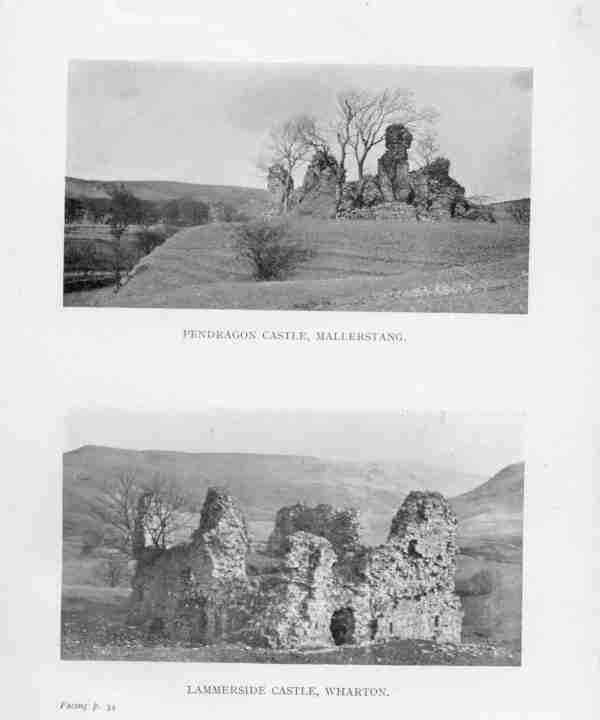
Our next stopping place, after
leaving Pendragon, was the Parish Church of St. Mary, formerly a chapel of
Kirkby Stephen, which stands at Outgill near the middle of the parish of
Mallerstang. There
was a chapel here in the Middle Ages, originally in the
Norman style, but the existing building was repaired and largely reconstructed
in 1663 by Lady Anne Clifford, after having been in ruins some 50 or 60 years;
she also endowed it with lands which she purchased in Cautley near Sedbergh.
So proceeding south toward the
Westmorland boundary, we entered an increasingly fine bit of country. On our
left the high Mallerstang Edge, on our right the majestic flat-topped Wild Boar
Fell and between them a narrow valley containing the river Eden and the Hawes
road. The scene has been described in "Paterson's Road," and, since this is a
rare publication of 1826, I will quote from it: "Among the eminences which rise
in this neighbourhood is Wild Boar Fell, the giant of the group, which soars to
a great height; it has a spacious plain on its summit, where the shepherds of
the vicinity formerly held horse-races and from whence the prospect is extensive
and highly interesting.
Where the road crosses the county
boundary, just south of Aisgill Farm, our two cars separated. My cousin went on
his way home to Burneside via Garsdale Junction and Sedbergh, while we three
others turned round and made for Kirkby Stephen and tea. The actual boundary is
at Hell Gill, of which mention is made in an article called "Mary Stuart in
Wensleydale"8:-
"Hell Gill cuts across an ancient
gate between Westmorland and Yorkshire. The modern highway clings to Mallerstang
Gorge, but up here, where the wind never rests, a strip of close-cropped grass,
among the surrounding heather, marks the way the Celt, Roman, Norsemen and Saxon
trod when bent of foray or feud."
KIRKBY STEPHEN
Kirkby Stephen is a small but
ancient market town on the west bank of the river Eden. It consists chiefly of
one long, broad street running north and south. In its layout it is a typical
mediaeval town, compact and complete: church, vicarage, manor house, market
place, grammar school (founded by Thomas, Lord Wharton in 1566) and the houses
all built of local stone, many of them looking neat and trim under their coats
of whitewash. The absence of any cross-road in the town given the street an
unusual effect of unbroken straightness, though there are several small
alleyways running off the main street, which you hardly notice until you are
passing them. Once when I went out to post a letter there was a man walking just
ahead of me; he was wearing white flannels and carrying a cricket bag, for there
was a match against Appleby that evening; I looked across the street for perhaps
a second, to see if I could find a grocer's shop, and in the twinkling of an eye
the cricketer in front of me had completely vanished. He had, of course, turned
down one of the alleyways, and had not been "swallowed up quick," as it seemed
to me walking behind him.
Kirkby Stephen church was
probably first founded in the 8th century and rebuilt towards the close of the
12th; it was completely pulled down and again rebuilt about 1230, but from the
end of the 14th to the latter part of the 16th century it underwent various
alterations. It is to-day a fine example of Early English and later styles
retaining traces of presumed Saxon work in the pre-Conquest stones. It consists
of a chancel with the Wharton chapel on the north and the Musgrave chapel on the
south, a nave of seven bays, aisles, transepts, south porch and an embattled
western tower built about 1500 in place of the central Early English tower which
fell in the 15th century. In the Wharton chapel is an elaborate altar-tomb on
which are three full-length figures: Thomas, 1st Lord Wharton who died in 1568,
his effigy shows him in armour with short hair and a long beard; on his right
side is Eleanor, his first wife, daughter of Bryan Stapleton, and on his left
side, his second wife Anne, daughter of George Talbot, Earl of Shrewsbury.
Pennant observes about this tomb: "the sleeves of one of the ladies are of a
most enormous length."
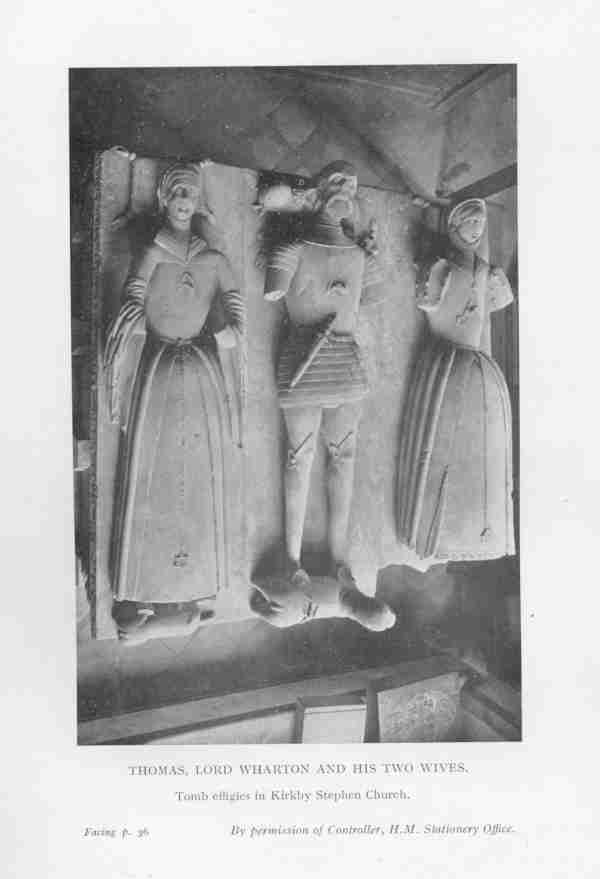 Another commentator has
paraphrased the Latin inscription thus:-
Another commentator has
paraphrased the Latin inscription thus:-
"I, Thomas Wharton here do lie
With my two wives beside me,
Ellen the first and Anne the next
In Hymen's bonds who tied me.
O earth, resum thy flesh and bones
Which back to thee are given,
And Thou, O God, receive our souls
To live with Thee in Heaven."
In the Musgrave chapel on the
south side is a plain altar-tomb to Sir Richard Musgrave, who died 1464,
Elizabeth his wife and Thomas his son, with the Musgrave shield-of-arms (Azure
six ring or) on the edge of the slab. In this chapel there is another and
earlier altar-tomb assigned to Sir Richard de Musgrave, grandfather of the above
Sir Richard. When this tomb was removed, on the rebuilding of the chancel in
1847, skeletons were found in a walled grave underneath the tomb; and in the
grave was also found a boar's tusk, confirming the local tradition that this
knight killed the last wild boar on Wild Boar Fell.
Kirkby Stephen Church is one of
the two largest in the county. Before the dissolution of the monasteries in the
reign of Henry VIII it belonged to St. Mary's Abbey, York, but afterwards,
unlike Kirkby Lonsdale, Heversham and Kendal in the same county whose advowsons
were all given to Trinity College, Cambridge, the rectory of Kirkby Stephen was
sold in 1547 by Edward VI to Sir Richard Musgrave who in turn re-sold it to
Thomas, Lord Wharton, in whose family it remained until the first and last Duke
of Wharton sold it to his steward, Matthew Swales. Subsequently it was bought by
an ancestor of the present patron, Lord Lonsdale.
After seeing the church we walked
across the fields towards Hartley, about half a mile away, on the east side of
the Eden. Hartley Castle was once a noble building standing on high ground
overlooking the village of Hartley and surrounded by its own deer park. But
to-day there is little enough left even of the ruins. By looking carefully we
found part of an old wall.
The castle and manor of Harcla or
Harclay or, as one authority spells it, Hardclay (adding "the soil of the place
sufficiently indicates the reason of the name") and more recently called
Hartley, was granted by Edward II to Sir Andrew de Harcla, whose rise and fall
were equally rapid and spectacular. He was in high favour with the King, was
appointed Lord of the Marches and Sheriff of Westmorland, was created Earl of
Carlisle and was rewarded with many grants. But his innings was a short one. He
did not enjoy his honours above a twelve-month; for, in 1323, he was caught
plotting with the Scots. Seized, by order of the King, he was brought to trial,
condemned to death after being formally degraded by having his sword taken from
his side and his spurs chopped from his heels, and was executed for high treason
at Carlisle. After his attainder the manor was sold to Sir Thomas de Musgrave
whose family lived here for several generations. In 1361 a licence to crenellate
the castle was obtained; in the reign of Elizabeth it was substantially enlarged
by Sir Richard Musgrave, who was later created a baronet by James I. The house
at this time surrounded a courtyard to the north where now stands the farmhouse.
For a long time the castle was kept in good repair, but in 1735 it was pulled
down by Sir Christopher Musgrave who removed the wood and lead to repair his
other seat at Eden Hall in Cumberland. The site is now occupied by farm
buildings and the fabric of the present house, especially in the doors and
windows, incorporates a good deal of the ancient stonework. We left the farm and
returned to the Kings Arms in Kirkby Stephen.
So ended our day spent for the
most part on the banks of the Eden. We had seen, inter alia, three ruined
castles - Pendragon, Lammerside and Hartley, formerly the homes of three
powerful Wesmorland families - Clifford, Wharton and Musgrave. To-day all the
glory and strength and dignity has departed from those strongholds and nothing
remains but a few old stones which the builders of a bygone age have rejected.
If there is a moral to be drawn, it is perhaps that it is better to get under a
public umbrella rather than remain in private hands out in the rain. In the
churches of Kirkby Stephen and Appleby there are at least the altar-tombs,
dusted periodically by caretakers to bear witness to the past greatness of those
families.
As I pondered on these things,
walking back to Kirkby Stephen, I remembered a story told me many years ago by
Sir Wilfrid Lawson of Brayton. There had been a sale of property somewhere near
Penrith; the old owners had gone; the place was in bad repair. Sir Wilfrid met
an old Cumberland woman in Aspatria, who began talking to him about this sad
event. (In telling the story he copied her voice in his own inimitable way).
"Ah," she said, "the glory has departed and over the door is written the word
knickerbocker."
1 There are several ways of
spelling the name of this tributary of the Lune. In various maps, guide books,
and directories I have found Rother, Rowthey, Rothay and Rothey, but I am
choosing Rawthey because that is the ordnance map version and because, if there
is a choice, I like the full, broad Westmorland sound of the word Rawthey.
2 Country Life, 25th July,
1947.
3 See p. 36 under Kirkby
Stephen church.
4 The barony of Wharton fell
into abeyance and so remained for many years. In 1916 the abeyance was
terminated in favour of Charles Kemeys-Tynte, a descendant of one of the
daughters of Philip, 4th Lord Wharton.
5 Preface to "The English
Country House." Batsford, 1935.
6 "Historical Monuments Survey,"
p. 163.
7 "Tour in Wales," 1781.
8 By G. Bernard Wood. Country
Life, 22nd March, 1946.
Thanks to Diane Coppard in Leicestershire for transcribing this! Reproduced by
permission of Tim Clement-Jones.





